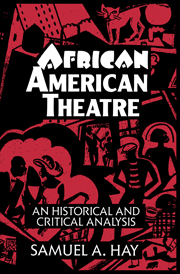Book contents
- Frontmatter
- Contents
- Acknowledgments
- African American Drama and Theatre: Outline of Schools, Periods, Classes, Subclasses, and Types
- Introduction
- 1 The Black Experience School of Drama
- 2 The Black Arts School of Drama
- 3 Theatre People: Some Splendid Examples
- 4 The Governance of Theatre Organizations
- 5 Development
- Conclusion
- Appendixes
- Notes
- Select Bibliography
- Index
- Frontmatter
- Contents
- Acknowledgments
- African American Drama and Theatre: Outline of Schools, Periods, Classes, Subclasses, and Types
- Introduction
- 1 The Black Experience School of Drama
- 2 The Black Arts School of Drama
- 3 Theatre People: Some Splendid Examples
- 4 The Governance of Theatre Organizations
- 5 Development
- Conclusion
- Appendixes
- Notes
- Select Bibliography
- Index
Summary
IF it were simply a question of the survival of African American theatre, there would be no need for yet another historical and critical analysis of African American plays, theatre people, and theatrical organizations. Up to today, this theatre has wheezed through more than one hundred seventy years, thanks to generous patching and propping. Given the circumstances, such a long existence is no small achievement. This prompts the question, What can be done to improve prospects for the further long-term health of this repository of African American life and history? To find answers requires a thorough examination of African American drama and theatre. Getting a fix on the plays demands, for example, a complete understanding of the general principles governing the works' methods, aims, functions, and characteristics. In this checkup, therefore, the first two chapters separate into schools, periods, and classes most of the plays written by African Americans between 1898 and 1992. The criteria are based on theories espoused by the philosopher Alain Locke (1886–1954) and the sociologist William E. B. DuBois (1868–1963) during the 1920s and the 1930s. The purpose of classification is to set terms and impose limits. Chapter 3 studies African American theatre people. Their condition today looks better than it actually is – thanks to the well-known few actors trained in community theatres during the thirties and the forties. These theatres now are on their deathbeds, however, because there are too few young people willing to brave the uncertainty of the theatre profession and the racial prejudice in the preparation. The third chapter, then, is a pep talk to the young and the tired.
- Type
- Chapter
- Information
- African American TheatreAn Historical and Critical Analysis, pp. 1 - 14Publisher: Cambridge University PressPrint publication year: 1994
- 2
- Cited by

